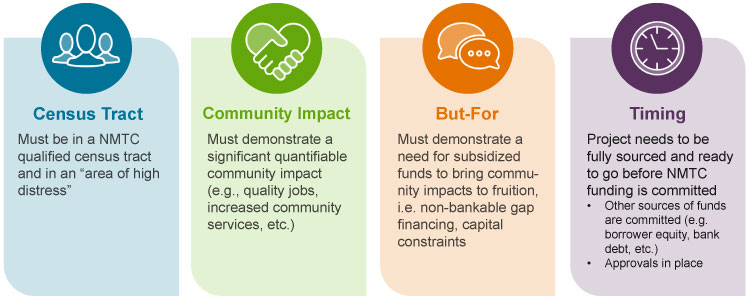Improving Capital Efficiency for Manufacturers Through the Use of New Markets Tax Credits
With economic headwinds pointing towards volatile times ahead, manufacturers are looking at ways to optimize capital spending to ensure the strength of their balance sheets. Given the unique structure and flexibility that the New Markets Tax Credit (NMTC) program offers projects in qualifying census tracts, NMTCs can be a powerful tool. NMTCs can decrease the overall cost of capital required for a manufacturer’s new construction, rehab or equipment project, making this program an attractive solution for companies during these uncertain times.
How Does the New Markets Tax Credit Program Benefit Manufacturers?
The New Markets Tax Credit program is a 39% tax credit earned over seven years. Given the shallow nature of the credit, the most common structure combines tax credit equity and sponsor leverage of equity or debt to unlock the tax credits’ full economic benefit. As such, the leverage provided by the sponsor and the tax credit entity fund a structure in which the tax credit equity buys down the interest rate of the leverage bought by the sponsor for the transaction. Moreover, during the seven-year compliance period, the loan has interest-only payments, improving liquidity for the duration of the compliance period. Thus, for manufacturers that are looking at ways to preserve liquidity and concentrate on capital perseveration, this program can accomplish both.
New Markets Tax Credit Considerations for Manufacturing Companies
While the program offers several benefits, there are several considerations to evaluate before pursuing NMTCs, such as location, community impacts and governance. The New Markets Tax Credit (NMTC) program is competitive, with more projects requesting NMTC equity than available by a material margin. Consequently, projects must exceed minimum standards and meet criteria in excess of the standard eligibility. First, while being located in a low-income census tract ensures project eligibility, the lion’s share of funded projects are in highly- or severely-distressed census tracts. There are several ways to meet the highly-distressed threshold, which NMTC experts can help sponsors explore for each site location. In addition, community impacts must be measurable. For manufacturers, having a significant job-creation element to the project is paramount to the success of receiving NMTC equity. Many funding entities like to see at least ten quality jobs created for every $10mm in allocation provided. Furthermore, partnerships with economic development entities and local employment, agencies, amongst other activities, increase the attractiveness of projects seeking NMTC equity. Finally, project sponsors will likely need to create a new entity, which will require a separate board or differentiation in ownership, which may create another hurdle for organizations.
What Makes a Good NMTC Project?
Qualifications and determination of the extent of subsidy based on these criteria:

Competitive/Great NMTCs Projects do not just meet the eligibility criteria, they exceed them as outlined above (being in an area of higher distress and producing quality jobs with job training and career ladder training). In addition, they should:
- demonstrate the need for the subsidy and use of the New Markets Tax Credit (NMTC) funds to produce the community impact; and
- have all other sources of funds needed for the project committed, have construction plans completed and contracts negotiated and building/zoning approvals in place.
Some projects can also benefit by being in a non-metro census tract or an underserved state (see the CDFI Fund mapping tool).
If a manufacturer can be comfortable with the New Markets Tax Credit program-related compliance, they seek to gain 15-20% of whatever Qualified Equity Investment is garnered. For example, in a project that is spending $40mm and receives $20mm in Qualified Equity Investments, the sponsor will benefit anywhere between $3.2-$4mm in cash for the project. Alongside the aforementioned benefits, this program can be a powerful component of the capital stack, given the current macro environment.
How Cherry Bekaert Helped Manufacturing Companies with the New Markets Tax Credit Program
New Markets Tax Credit case studies for industrial manufacturing clients:
- NMTC Case Study for Vestil Manufacturing
- NMTC Case Study for Greenco Distribution
- NMTC Case Study for Associated Hardwoods
- NMTC Case Study for Rooms To Go
- NMTC Case Study for Arris Manufacturing
Contact our professionals to discuss the New Markets Tax Credit Program opportunities for your manufacturing company.
